iay 2 of a 3-day Autumn Migration & Wader Spectacular tour. It was misty first thing but it burnt off quickly. By the time we got to the coast, the sun was already out and it was a bright sunny day with lots of blue sky. We spent the day along the eastern part of the North Norfolk coast.
With a big tide, we headed to Stiffkey first. As we walked down along the permissive path, the hedges were adorned with cobwebs which were covered in dew and glistened in the morning sun. A Robin was singing in the copse and a Cetti’s Warbler shouted as we walked down the footpath but there was no sign of the tit flock along here today. We could hear Greenshanks calling out on the Fen.
Up onto the seawall, we could see lots of Spoonbills out on the Fen. More unusually, most of them were awake! Most were in the water and busy bathing and preening.
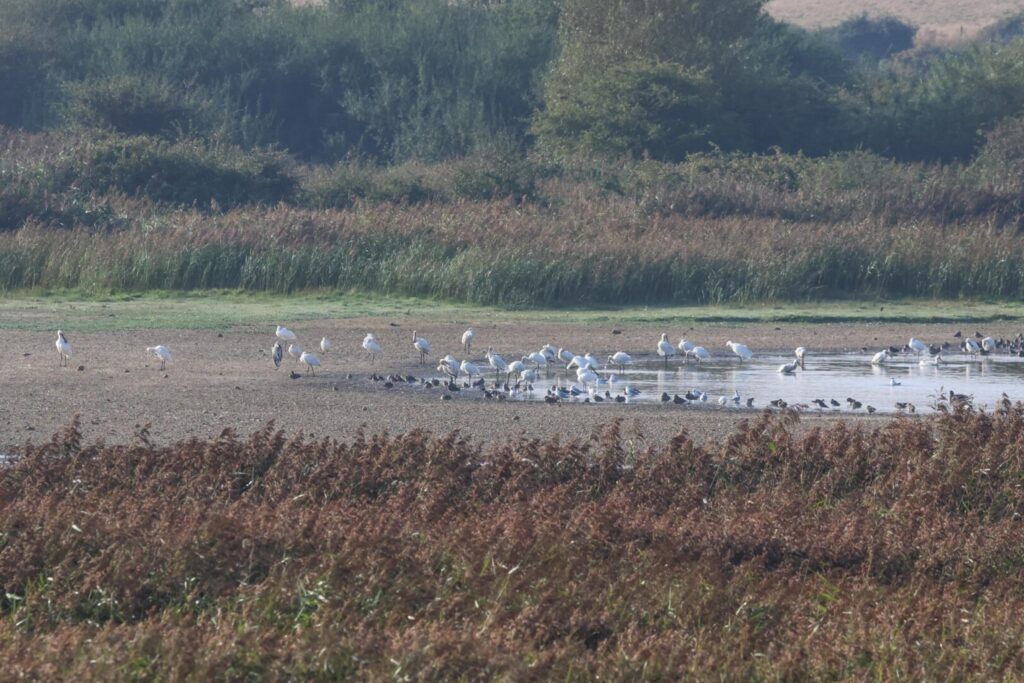
It was high tide, and the sea had completely covered the saltmarsh. There were lots of Black-headed Gulls swimming where there would normally be grass and Little Egrets scattered around on every high point which was sticking out above the water.
A succession of small flocks of Redshank flew in past us and dropped onto the Fen. Lots of Curlews were trying to roost out on the old dune ridge but were flushed by a couple of canoes and flew round trying to find somewhere else to land. A flock of Golden Plover came over high calling.
There were several Brent Geese out on the water, away to our left, but they too were flushed by the canoes. They flew past us and on further round the harbour. They are only now starting to return from summer in Siberia, back here for the winter. We could see a few Grey Seals pulled out on the Point in the distance. Several juvenile Gannets flew round out over the harbour entrance.
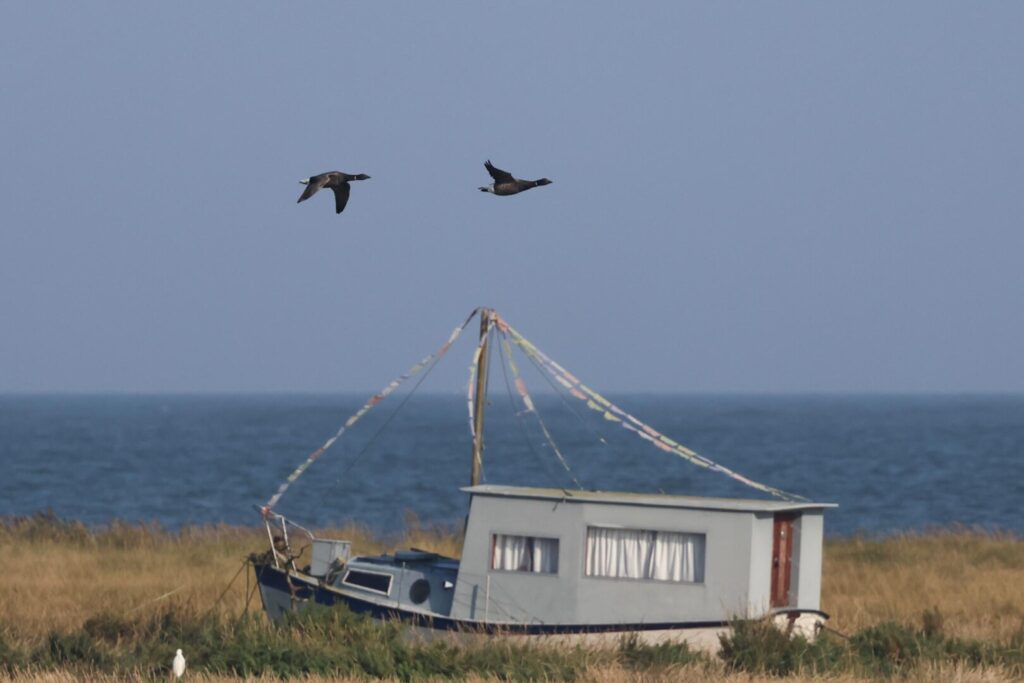
A Kingfisher flew in from the saltmarsh and over the bank, disappearing behind the sallows along the river in a flash of electric blue. Not long after, it flew back out, and circled round over the saltmarsh. It stopped to hover a couple of times, maybe looking for somewhere to land, then did another circuit before flying back in and disappeared down into the river channel again.
From further up along the seawall, we had a better view of the Fen. There were lots of Redshanks on here now, spread around the edges of the water, and a good number of Black-tailed Godwits with them. A few Ruff were walking round on the mud. Three Ringed Plover dropped in.
Further along still, we finally found the Greenshanks tucked in the corner. They immediately stood out, much paler, whiter below than the Redshanks. We counted about forty of them. A Common Sandpiper appeared on the edge of the reeds just beyond. We had heard a Spotted Redshank call distantly earlier, and scanning through the Greenshanks we now found a dusky grey juvenile Spotted Redshank in with them. It must have dropped in earlier.
Several Egyptian Geese flew in and dropped down onto the islands. Several Reed Buntings were flicking around in the reeds below the bank, pushed out of the Suaeda on the saltmarsh by the tide. A Great Spotted Woodpecker flew in and landed in the hedge by the coast path. Perhaps a migrant on the move?
There was no point going further today, so we turned to walk back. It was warming up now. More dragonflies and butterflies flew up ahead of us along the path and a Hornet mimic hoverfly (Volucella zonaria) landed in the hedge next to us.
We made our way on east to Cley next, and parked in front of Walsey Hills. A small covey of Red-legged Partridges were hunkered down in the edge of the field beyond Snipe’s Marsh. We could hear the shoot coming – how many would still be alive when we came back? A Red Kite hung in the air over North Foreland plantation.
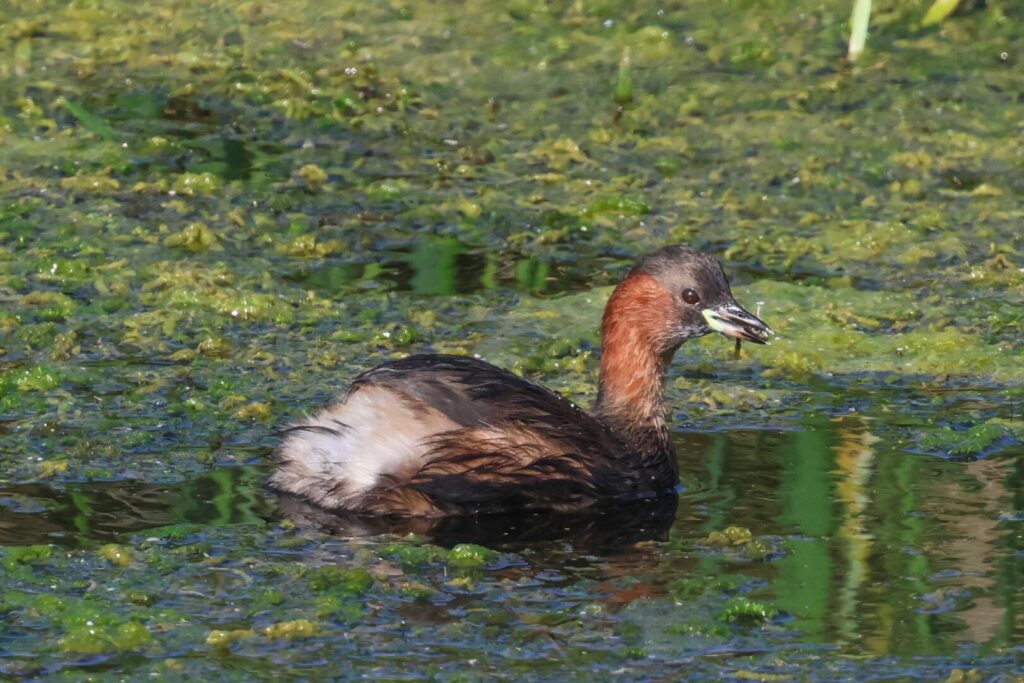
Walking up the East Bank, we watched a Little Grebe on Don’s Pool catch and eat a stickleback. A Reed Warbler flew across and disappeared into the bulrushes at the back. We could hear a Bearded Tit calling and a Water Rail squealing but bother remained well hidden.
There were lots of Canada Geese and Greylags out on Pope’s Marsh. A large flock of Wigeon was feeding out on the grass. A small flock of Pink-footed Geese flew in low over the reeds and over the path ahead of us. We had a good view of their dark heads and more delicate, darker bills compared to the other geese. They landed on Pope’s Pool where we could see how much smaller they are compared to the Greylags.
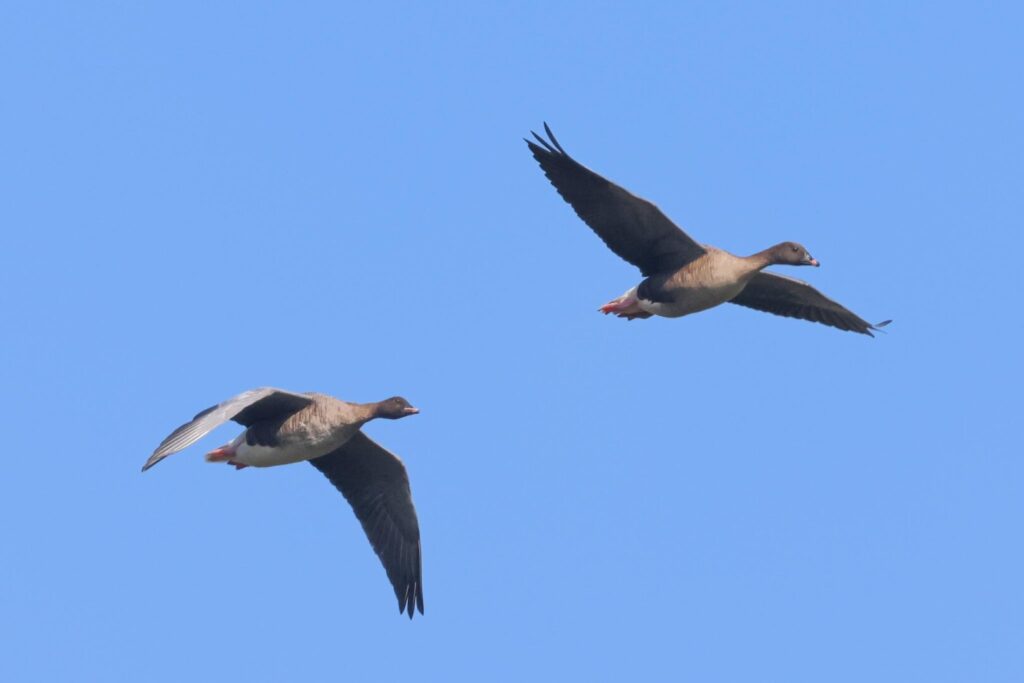
Scanning inland, we picked up several Common Buzzards circling up in front of the Hangs. A Hobby appeared with them, and made a few little swoops at one of the Buzzards before they all drifted off their separate ways.
A Chiffchaff flew in calling and landed in the edge of the reeds at the bottom of the bank. It didn’t stop long, and flew on again, over the reedbed heading towards the coast road. Possibly a migrant, fresh in and looking for somewhere to feed. There had been a Redstart along here earlier and suddenly it appeared from the reeds on the bank right in front of us. It kept dropping down to the grass, and back up to perch on the reeds, looking for food. Another autumn migrant stopping off on its way from Scandinavia to Africa.
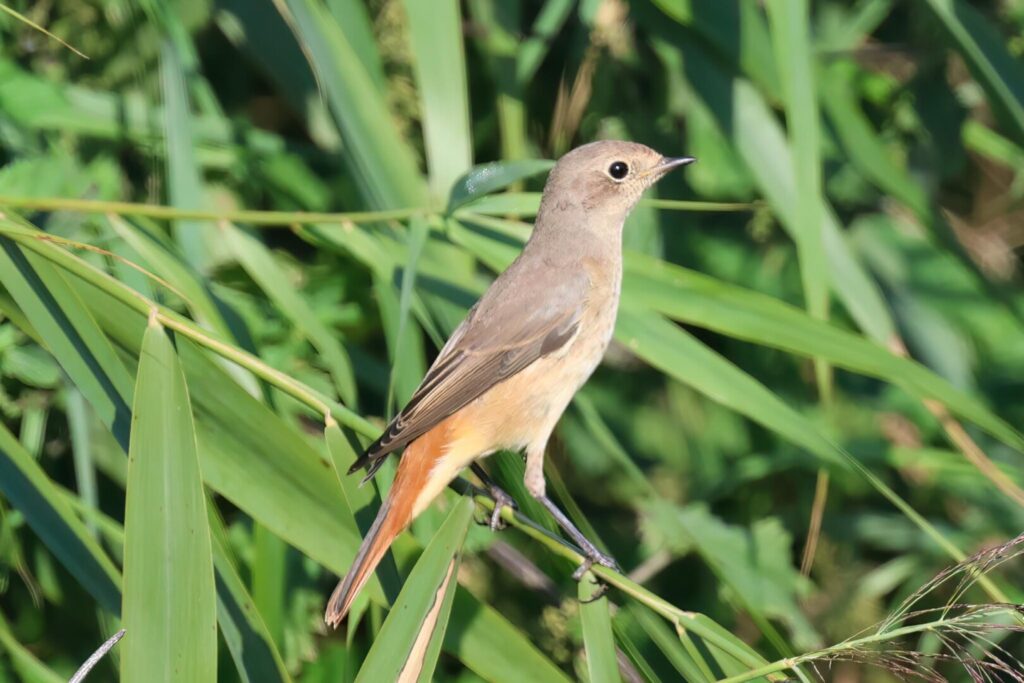
When some dog walkers came the other way, they walked straight up and flushed the Redstart. It flicked over the reeds and disappeared down into the ditch. We had only gone a few more metres and we found a Reed Bunting feeding on the gravel path now. The next dog walkers to come back from the beach politely waited while we watched it and only walked on when it flew of its own accord. Another Bearded Tit called, and this time we looked over in time to see if fly off over the reeds.
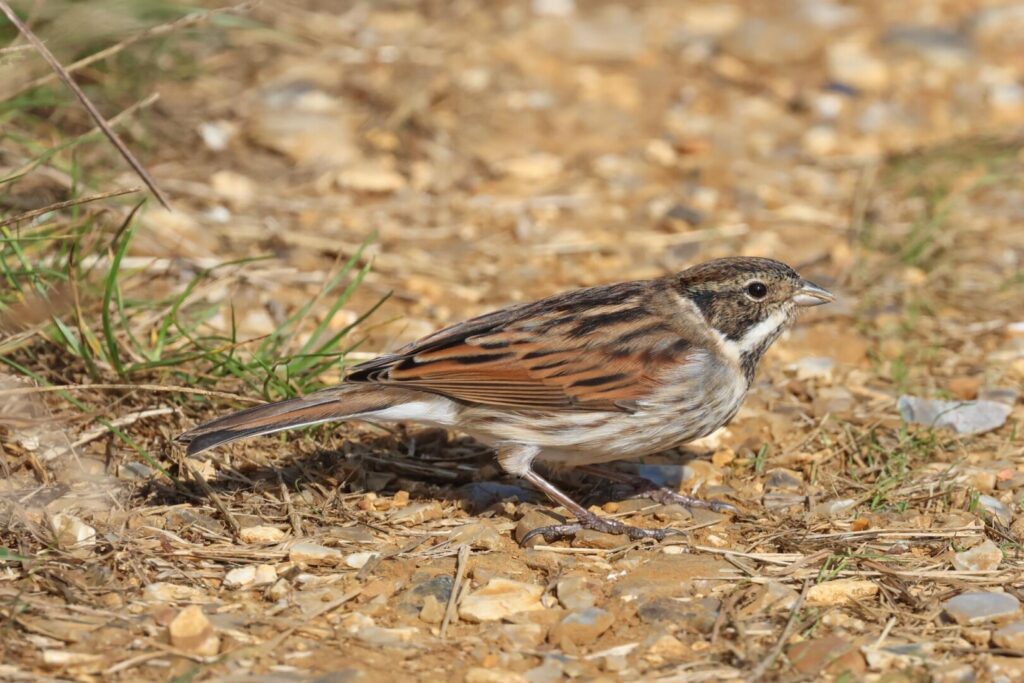
There were several Ruffs on the Serpentine, a mixture of grey-and-white adults with orange legs and browner, dark-legged juveniles. We had a discussion about how they are always a source of confusion for the unwary. Four Dunlin dropped in to feed briefly. Several Black-tailed Godwits were probing in the deeper water.
Lots of Curlew flew up from Arnolds and headed off west. Presumably they had roosted here over the high tide and were going back out to the harbour now. Further up, all the waders spooked off Arnold’s and we watched more Curlew fly off, along with five Knot and a single Bar-tailed Godwit. We were then distracted by two Kingfishers which chased along the main drain towards us, cut round over the brackish pool and the edge of Arnold’s, and disappeared off east over the main drain. We picked up the Hobby again, this time hawking over the reedbed back towards the Visitor Centre.
Out on Arnold’s Marsh, there were still more Curlew roosting on the saltmarsh along the southern edge. Lots of Redshank were mostly feeding out on the water, along with a few Dunlin. A single Greenshank was sleeping on the sandbar at the back. The five Knot flew back in. Looking out over the Brackish Pool, we found a single eclipse drake Pintail upending. Out at the beach, it was lovely in the sunshine but the sea was rather quiet today. We picked up a few distant Gannets passing by well offshore and an even more distant Common Scoter.
On the walk back, we came across a couple struggling to identify the Ruff on the Serpentine, so we put them out of their misery. A Common Snipe was bathing in the water here now. The Redstart flicked up off the bank and back into the ditch again.
It was time for lunch, so we made our way round to the Visitor Centre. We ate on the picnic tables overlooking the reserve, a lovely place to sit in good weather like today. Several hundred Lapwings were roosting on Pat’s Pool and flew up repeatedly – apparently there had been a Peregrine about and they were clearly nervous. Several Swallows flew through, over the car park and past us, migrants on their way to Africa for the winter. It was so nice today we even stopped for ice cream!
After lunch, we headed round to Kelling. There had been a Barred Warbler in Burnham Overy Dunes this morning, and we figured this is a good a place as any to find another one, or we might be able to find a Whinchat. Several House Martins were still feeding in the sky over the school. A Greenfinch was calling in the trees by the pumping station and several Goldfinches landed in the top of the big fir tree. A couple of Skylarks flew over calling.
There were lots of butterflies & dragonflies enjoying the sunshine in the lane. We stopped to look at the Ivy Bees collecting pollen from the ivy flowers and were amazed at the amount of activity – bees, hoverflies and several Red Admirals.

Scanning from the metal gates, we could see that the vegetation out in the middle of the Water Meadow had recently been topped. We could see a couple of Stonechats flicking up and down occasionally from the brambles and a few Linnets perched on the bushes, but they were hard to see where they were.
From down on the crosstrack, we looked back at the pool. There were several Teal, Shoveler and Wigeon on the water, along with a couple of Coot. A Black-tailed Godwit and two Ringed Plover were on the muddy shore, with a Little Egret just beyond. More Linnets circled over calling.
Continuing on down towards the Hard, a Wheatear flew in and landed on a bramble bush close to the path. Looking out across the Quags, we could see another feeding in the distance out on the short grass. Some migrants, at least.
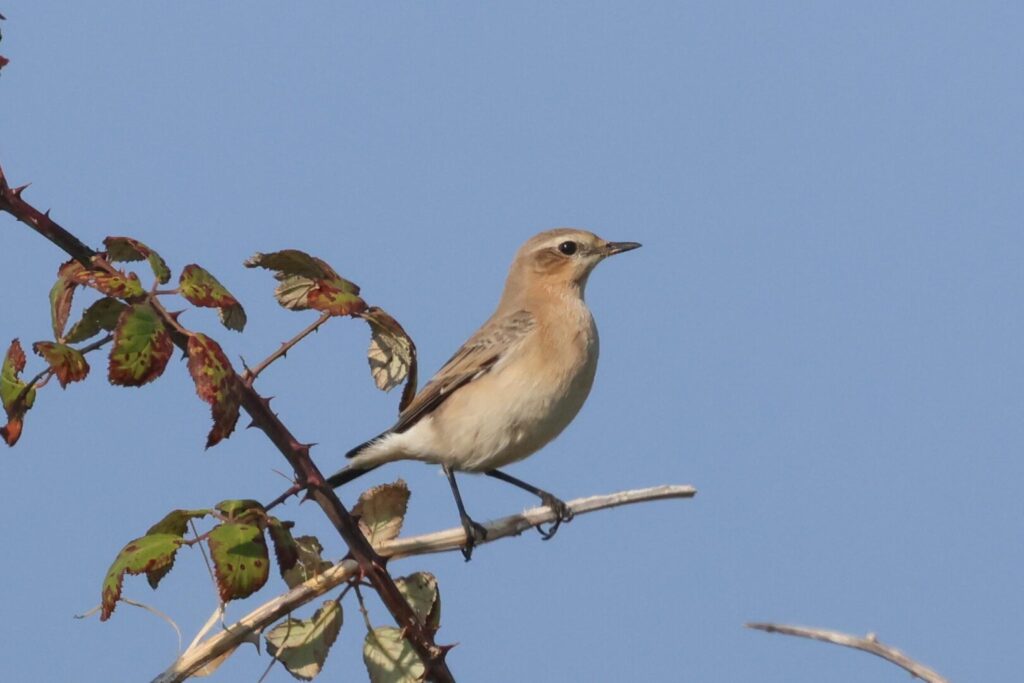
We turned up the permissive path towards the guns. Scanning the sea, we picked up six Eider flying past just offshore. A few more Gannets were a little closer than they had been earlier.
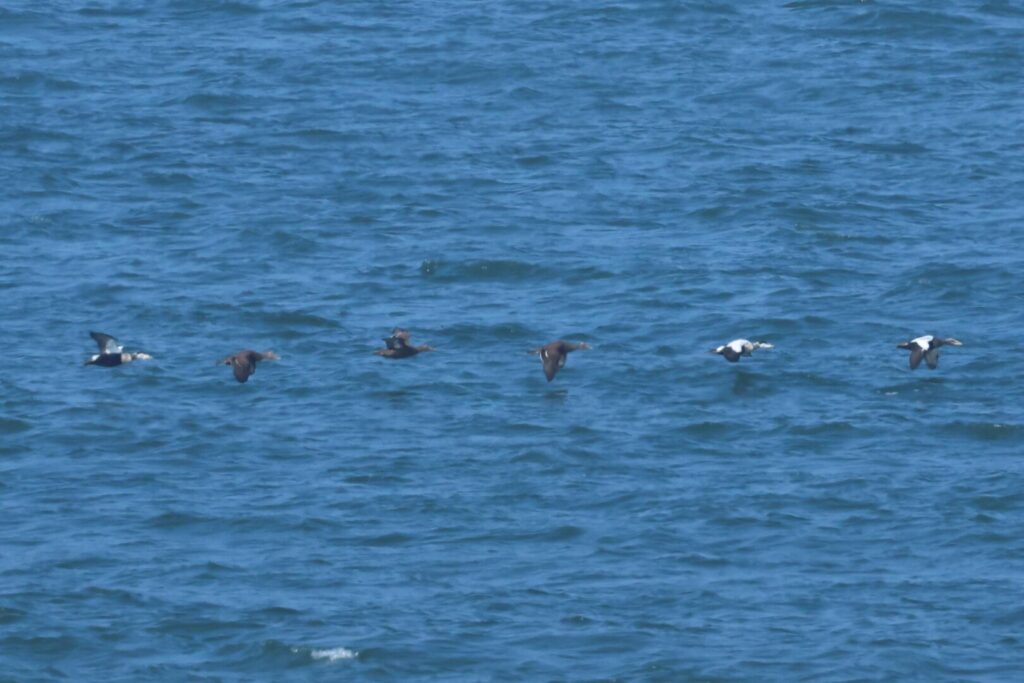
Up by the guns, we found a couple more Wheatears. By the UEA pollution monitoring centre, we found at least 8 Wheatears together now, there had obviously been a small arrival. A Curlew flew in and landed on the airstrip. But apart from a couple of Meadow Pipits, we couldn’t find anything else along here this afternoon.
We turned around and walked back down to the Hard. There were now at least four Wheatears on the Quags. It was a good afternoon for them, at least, but had anything else come in? As we made our way back along the track towards the Water Meadow, we stopped to look at a Brown Hare in the field. A large covey of Red-legged Partridges, released to shoot here, scurried away through the grass.
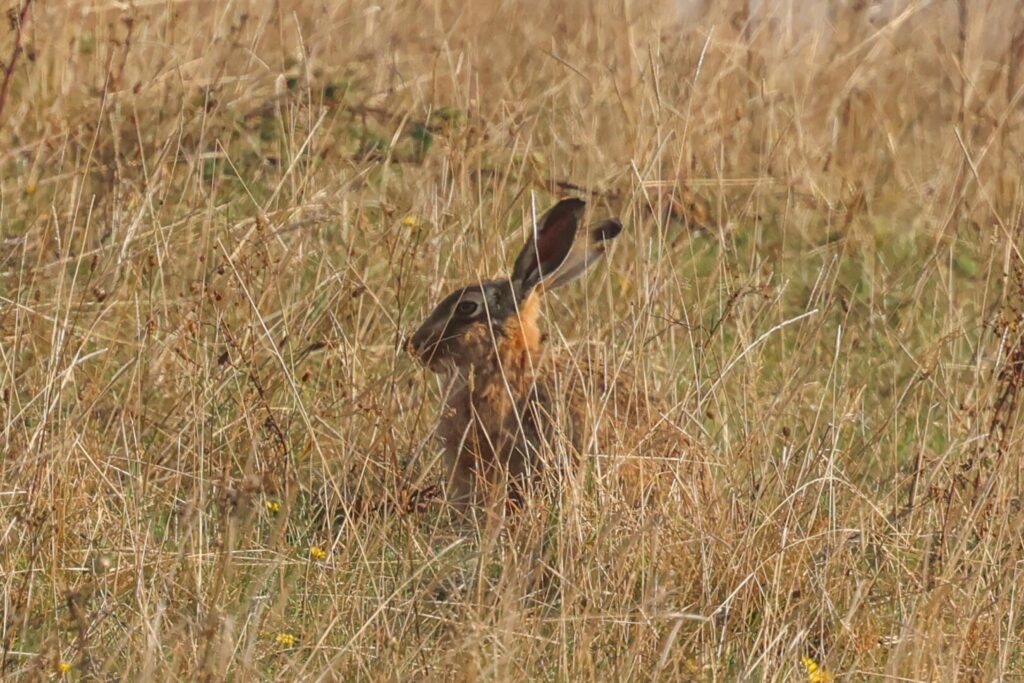
As we passed the Water Meadow, we were just wondering whether there may be time for one last quick stop if we hurried back to the minibus. As we looked across, we noticed that the Stonechats had now moved slightly closer to the pool, so we stopped for a quick scan to see if we might find a Whinchat with them. There were at least six of them here now.
One of the male Stonechats chased something paler from the hedge at the back. They can chase Whinchats like that, so we thought our luck might be in. When they landed on a large bramble bush we put the scope on them. They were still a long way off, but we could see it wasn’t a Whinchat. It looked like a male Stonechat, but rather pale. The bright sunlight wasn’t helping, so perhaps that was just making it look pale? Then it moved and we got a flash of its pale rump – it was an ‘Eastern Stonechat‘! A proper rarity!
It was impossible to pick up with binoculars but it hopped up onto the top of the bramble so we tried to get everyone a quick look through the scope. Agonisingly, after the first couple of people got to see it briefly, suddenly it had disappeared. Presumably it had been chased off by the pesky Stonechat again. Where had it gone? We knew we needed to see it better, and hopefully get some photos to identify it to one of the two species, Siberian or Amur Stonechat.
The Stonechats all seemed to be making their way back towards the Hard, so we figured our best bet would be to try to catch them there. They often like to feed along the fence line on the edge of the bramble field by the path to the Hard, so we made our way straight over there. A couple of Stonechats flew across the field and over to the fence as we arrived. As we scanned the bushes, a male Stonechat chased the ‘Eastern Stonechat‘ out into the grass in the field. Bingo!
In better light and much closer now, we all finally got a good look at it. It kept flying out into the field and then back up onto the brambles or fence, where we could get it in the scopes. Now we could see it better it looked very frosty, with a big and strikingly pale rump. It looked perfect for a 1st winter male Siberian Stonechat. Breeding from E Russia to Central Asia and wintering down to India, Siberian Stonechat is a rare visitor here.
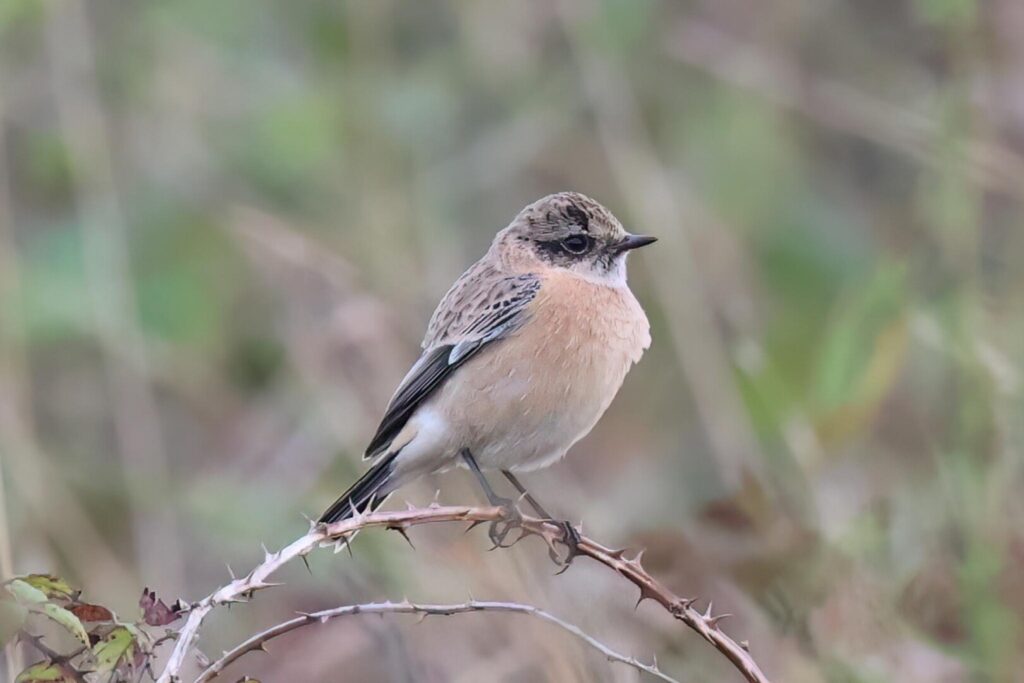
There were a few other birders who happened to be walking along the track so we called them over. They seemed a bit incredulous at first, until they set eyes on the Siberian Stonechat themselves. We put the news out and watched it for a while, until it disappeared up over the back of the field. Then we had to head back or we would be late for dinner. As we walked back up the lane, the first birders were starting to arrive to try to see it. What an end to the day!
POSTSCRIPT: We went back a couple of days later, after finishing with the group, and managed to get some better photos, in particular of its rump. Siberian Stonechat was only recently split from Amur Stonechat and identification of some individuals can apparently be complicated. Reviewing the photos with the 2023 British Birds article ‘Identification of
extralimital Siberian and Amur Stonechats’, this bird does look to be safely identifiable in the field as a 1st winter male Siberian Stonechat (and therefore no need to collect DNA!).

If you enjoyed reading about what we got up to and would like to join us on one of our forthcoming tours, you can see what we have planned on our Tours page here.
















